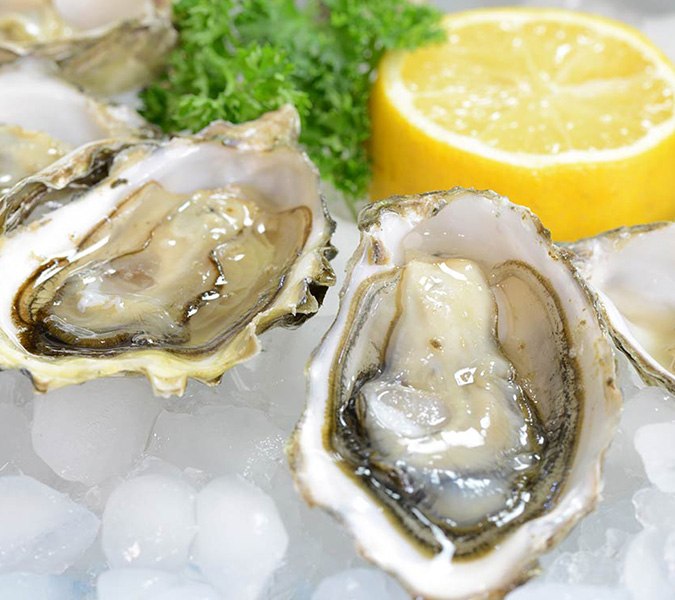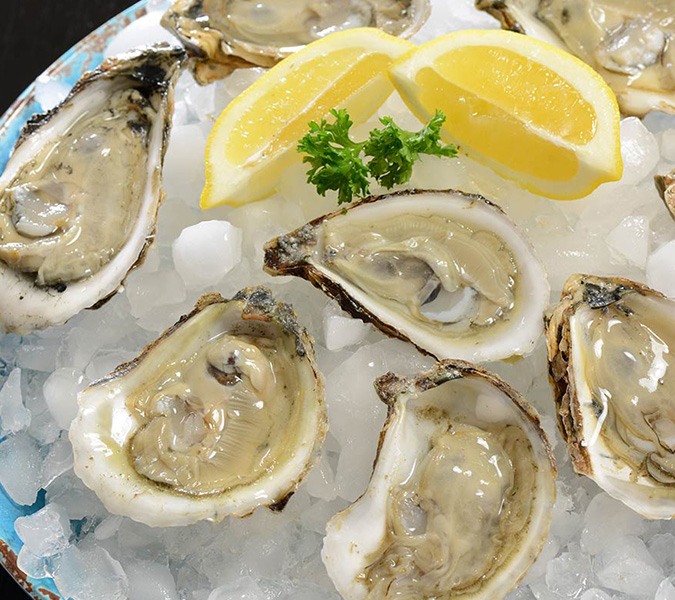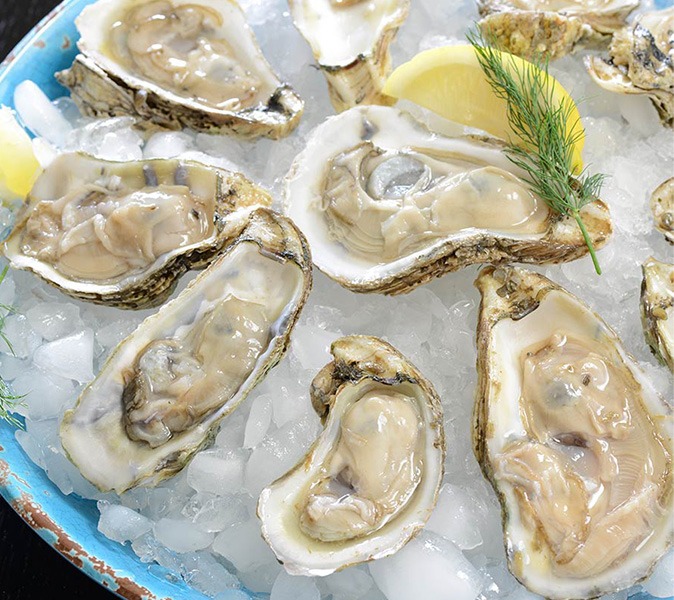There are a ton of good reasons to add oysters to your diet. Firstly, they’re one of the most delicious foods on the planet, and can be enjoyed raw from the shell, grilled, steamed, or fried, and incorporated into dozens of different dishes and cuisines. Secondly, most oyster farms have a low impact on the natural environment and are managed to ensure high sustainability. But best of all, oysters are an extremely nutritional addition to your diet. In this guide, we’re going to outline the many ways in which oyster nutrition can benefit you.
Per 1 serving (3.5oz/100 grams)
- Calories: 79
- Protein: 9 grams
- Carbs: 4 grams
- Fat: 3 grams
- Zinc: 555% of (DV)
- Vitamin B12: 538% of DV
- Copper: 493% of DV
- Selenium: 56% of DV
- Iron: 40% of DV
- Manganese: 20% of DV
- Phosphorus: 12% of DV
- Vitamin E: 9% of DV
- Riboflavin: 9% of DV
- Calcium: 7% of DV

Health Benefits of Oysters
Oysters offer a ton of health benefits, thanks to their huge stockpiles of essential vitamins, minerals and organic compounds. They’re an excellent source of protein, vitamin D, zinc, iron and copper, and also have high levels of Vitamin C, phosphorus, niacin and riboflavin. But it doesn’t stop there. They’re also rich in beneficial antioxidants, healthy cholesterol and omega-3 fatty acids. With all these impressive nutrients contained in such small portions, these are a god among superfoods, seriously boosting your body’s health and overall functions. Let’s look at some of the many benefits your body can receive.
Weight Loss
As we just discussed, oysters are packed to the brim with nutrients, yet they have one of the lowest calories-to-serving-size ratios of any food out there. People often turn to chicken when seeking a low-calorie, protein-rich meat, yet oysters have around half the calories per serving size as chicken! If you’re trying to lose weight, you can enjoy the exquisite taste of oysters without having to worry that they’re fattening.
Heart Health
Like fish and other seafood, oysters are rich in omega-3 fatty acids, which are considered a healthy fat or cholesterol. They have been proven to reduce the chance of plaque accumulation in the blood vessels and improve overall cardiovascular health. Their vitamin E content also increases the strength of cellular membranes, further protecting against heart disease.
Blood Circulation
With their high potassium and magnesium content, they can lower your blood pressure and increase circulation and blood oxygenation. Meanwhile, their rich stockpiles of iron help formulate red blood cells, boost the body’s metabolic rate, and defend against conditions such as anemia.
Bone Strength
With a wealth of healthy minerals in every serving, oysters can massively improve the strength of your bones. Calcium, iron, zinc, phosphorus and selenium all help increase bone durability, and protect you from conditions such as osteoporosis.
Immunity
You may have heard about antioxidants before. Famously found in teas, herbs and fresh vegetables, antioxidants fight against dangerous free radicals in the body, thereby reducing risk of heart disease and premature aging. Well, it so happens these are also rich in antioxidants, not to mention Vitamin C and Vitamin E, all of which go a long way towards strengthening the body’s immune system.
Aphrodisiac
Oysters have long been recognized as an aphrodisiac, particularly due to their high zinc content. For men especially, zinc has been shown to improve sexual drive and masculinity.

How to eat oysters
Oysters are a delicacy that can be enjoyed in many ways, even right out of the ocean! Covered in a hard shell, these molluscs do need to be shucked first, which is done with a knife. Then, just toss them back with a little lemon oil and salt. But that’s just the beginning!
You can also savor them grilled or broiled, or even cover them with panko and fry them up. Add them to risotto or pasta dishes, or make them into a delicious chowder. A classic? Oysters Rockefeller, a dish of baked oysters over a delicious butter spinach sauce.
Varieties of Oysters
Out of the 200 types of oysters that exist in the ocean (yes, 200!!)Only 5 are typically found for consumption in the United States. Those include:
Pacific oysters, known as Gigas, which depending where they’re found and harvested, include Pacific Golds, Pacific Rock Oysters, Sweetwaters, Emerald Cove and other popular varieties.
Atlantic or Eastern Oysters:
Sweetener and more briny than the Pacific varieties, Atlantics can taste very differently depending on the area where they’re harvested, the ocean temperature especially being a defining factor. There’s the Olde Salt from VIrginia, Rappahannock River, Rochambeaus from the York River, Blue Points from the Long Island sound, and the list goes on!
Kumamoto Oysters
Kumamotos are cherished for their small size and sweet, mildly fruity flavor, often featuring hints of melon or cucumber. These have a creamy, buttery texture and a clean, briny finish, making them a top choice for both beginners and connoisseurs. Originally from Japan, Kumamotos are now primarily farmed on the West Coast of the United States, especially in Washington and California, where they have become extremely popular. Their mild, approachable taste makes them perfect for enjoying raw on the half shell, with just a touch of lemon or mignonette to enhance their natural flavors.
Olympia Oysters
Olympias, the only native species to the West Coast of the United States, offer a distinctively robust and complex flavor profile. These tiny oysters pack a punch with a sweet, metallic taste and a slightly smoky, lingering finish, often compared to a mix of celery and copper. Due to historical overharvesting and environmental challenges, Olympias are now rare and farmed in limited quantities, making them a sought-after delicacy among oyster enthusiasts. They are best enjoyed raw, allowing their unique flavor to shine, perhaps with a squeeze of lemon to accentuate their natural brininess.

European Flats (Belon Oysters)
European Flats, also known as Belons, are known for their bold, briny, and metallic flavor, with distinct notes of seaweed and a powerful coppery finish. Originating from Europe, particularly France and the UK, these oysters have been introduced to North America and are now cultivated in regions like Maine and Washington. Their strong and complex taste appeals to a more niche market of oyster lovers who enjoy a more intense experience.
European Flats are typically eaten raw on the half shell, often with minimal seasoning to let their natural flavors take center stage, though they can also be paired with robust sauces or even a splash of whisky for the adventurous palate.
When Oysters Are Best
There’s an old rule that states that you should only eat oysters during the months that have an “R”. This is because this is when they’re in season and ready for harvest. That means April to September, but you can eat Rock oysters at any time.
Storage and Food Safety
If you bought live oysters, you can keep them in the fridge, large side down for about 3 days - the sooner you eat them the better the taste! For shucked oysters, refrigerate and eat the same day. Store separately from other foods and use utensils exclusive for them to avoid cross contamination and any unwanted effects.
There is always a risk when eating raw oysters, no matter where you source them from, so be aware and prepared for the risk, as with any raw meat, of food poisoning.
How to Prepare Oysters
To clean live oysters, scrub the shells under cold water, discarding any that are cracked, damaged, or don't close when tapped. To shuck, wrap a towel around your hand for protection, hold the oyster with the hinge facing you, and insert a shucking knife into the hinge gap. Twist gently to open the shell, then remove the top shell and free from the muscle, leaving it in its juices. Pick out any shell fragments carefully.
For frozen, thaw in the fridge for at least four hours before eating immediately.
Conclusion
While oysters are a super healthy source of minerals, vitamins and proteins, we strongly recommend not over-eating them! As with anything, moderation is key, even for vitamins and minerals. Eat oysters regularly, by all means, but be sure to rotate them with fish, chicken and other healthy sources of protein so you can benefit from a wide range of different nutrients. Variety really is the spice of life!
We also recommend you purchase from a trusted source, such as Gourmet Food Store. We always provide fresh, raw oysters that have been processed in an extensive facility built for cleanliness and meticulous preparation of all seafood products. We also deliver them to you in chilled containers, ensuring they stay fresh all the way to your doorstep.